
JAPANESE PRINTS
A MILLION QUESTIONS
TWO MILLION MYSTERIES
Ukiyo-e Prints浮世絵版画 |
| Port Townsend, Washington |
|
UTAGAWA TOYOKUNI III & UTAGAWA HIROSHIGE 三代歌川豊国 *** 歌川広重 さんだい.うたがわ.とよくに *** うたがわ.ひろしげ |
||
|
Series: A Selection of Ten Flowers |
||
|
當盛十花選 |
||
|
Subject: The Cotton Rose* (芙蓉 or ふよう) |
||
|
Mat Size: 16" x 20" |
||
|
Print Size: 14 3/8" x 9 1/2" |
||
|
Publisher: Ebisuya Shoshichi |
||
|
恵比須屋庄七 |
||
|
えびすやしようしち |
||
|
Date: 1854, 6th Month |
||
|
Kaei 7 |
||
|
嘉永7 |
||
|
Illustrated:
Another copy of this print is shown on
line at the Boston Museum of Fine Arts |
||
|
SOLD! |
|
A full set of these prints is displayed on the Internet at the Tsubouchi Memorial Theatre Museum, Waseda University. Each print is clickable and can be enlarged for better viewing. *** Not only can you find a plethora of source material at this site, but you may even find another example of a print you own or other related prints. Many of these are unpublished elsewhere. *** (Unfortunately for non-Japanese language readers this site is a bit difficult and daunting at the beginning, but is an invaluable source displaying more than 47,000 images and well worth a visit.) |

|
|
|
|
|
|
|
|
Publisher's Seal: Ebisuya Shoshichi
Trimmed on the right. |
|
|
Date & Censor Seals: 1854, 6th Month |
|
|
|
|
|
|
|
|
|
|
|
|
|
|
|
|
|
|
|
|
|
Signature: Toyokuni ga
- within the toshidama cartouche |
|
|
Signature: Hiroshige ga
This signature is difficult to see, but can be found in the upper right quadrant. |
|
|
|
|
|
|
|
|
風鈴 ふうりん FURIN THE JAPANESE WIND CHIME |
||
|
|
||
|
It has surprised me how sparse the information is about furin in English and I am not sure it is much better in Japanese. All that I could find stated that they are made from several different materials: metal, glass, bamboo or pottery. They are a standard of the Japanese home in the summer. They are hung from the eaves of the house and often have a poem written on paper, i.e, a tanzaku (短冊 or たんざく), hung from the clapper. |
||
|
|
||
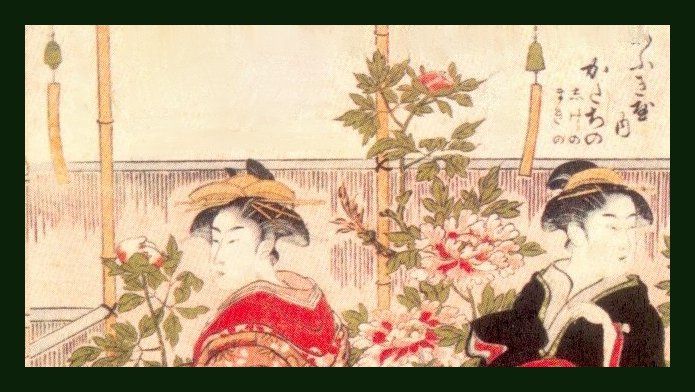 |
Kiyonaga courtesans amid flowers and furin | |
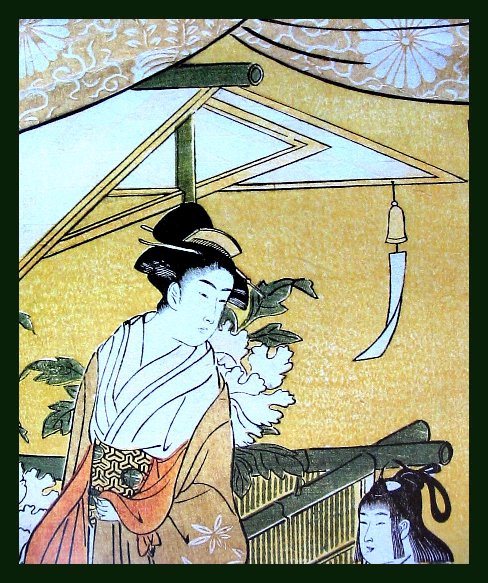 |
||
|
Eishi bijin and child among flowers and a furin |
||
|
Surely there is a symbolic significance to these bells. There is to almost everything else so why should these be any different? Like all objects there must be a history. There must be an earliest form and there must have been a transformation through the ages. IF ANYONE OUT THERE KNOWS ANYTHING SUBSTANTIVE ABOUT FURIN I WOULD APPRECIATE IT IF YOU WOULD CONTACT ME. |
||
| In this configuration the first character 風 means 'wind' and 鈴 means 'bell'. | ||
|
HIROSHIGE and the hibiscus *** sort of (because they are not all properly speaking hibiscus or of the same genus) |
|||
|
|
|
|
|
|
Hiroshige and Toyokuni III were paired together in several sets of prints. I would like to say that they had chosen to work with one another, but I don't know if it was their decision or that of their editors. In any case, they both brought a sure hand and great reputations to such projects. * Hiroshige had long had a reputation for the creation of kacho-e (花鳥絵 or かちょうえ), i.e., bird and flower images. There was an ancient tradition of such images going back to some of the finest Chinese painters. While Hiroshige was not the first to produce such imagery he was among the best. The overall size of his all-inclusive ouevre is astounding and among these are a number of representations of hibiscus and related flowers. Below are a selection of details of some of these prints. |
|||
|
|
|
|
|
| NONE OF THE IMAGES SHOWN IN THIS SECTION ARE FOR SALE! | |||
 |
|
||
 |
 |
||
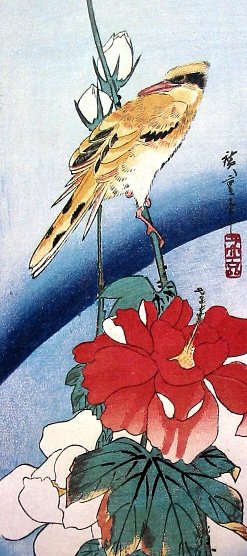 |
|||
|
Just a note: Ever since I first learned about the existence of kacho-e as a separate genre of Japanese prints I have been a bit stupefied by the translation of the first two characters. Literally they should read as 'flower bird', but that is not how we refer to them. I couldn't possibly explain this disconnect to you except to say that perhaps 'bird and flower' trips off the tongue a little more easily. Go figure. |
|||

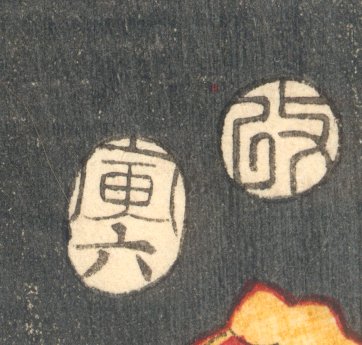


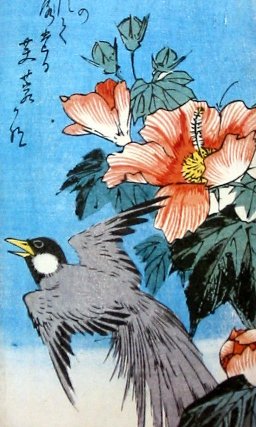
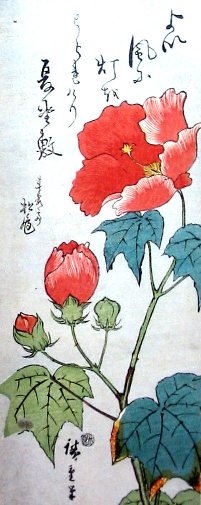
 HOME
HOME